Comprehensive Korean Food Guide For Travelers

🇰🇷 The Ultimate Korean Food Guide for Travelers
Discover What to Eat in South Korea and How Much It Costs.
Planning to visit South Korea? Discover the must-try Korean foods across categories like BBQ, noodles, rice dishes, and street food, with prices and insider tips included.
🔥 1. Korean BBQ (고기구이)
📍 Best for: Meat lovers, group dining
💰 Price Range: 15,000–100,000+ KRW per person
Cook-your-own meat at Korean BBQ restaurants for an immersive experience.
Korean BBQ is a sizzling, social dining experience where diners grill their own meat at the table. It's popular with locals and travelers alike for its interactive format and variety of meats. Meals are accompanied by lettuce wraps, garlic, ssamjang (dipping sauce), and a parade of banchan (side dishes). Be prepared for smoky flavors, laughter, and full bellies.
Must-Try:
Hanwoo (한우): Korea’s premium native beef, richly marbled and tender. Typically served as sirloin (등심), ribeye (꽃등심), or tenderloin (안심) at upscale BBQ spots. Its deep flavor and melt-in-your-mouth texture make it a gourmet experience worth the price. (40,000–100,000+ KRW per order)
Samgyeopsal (삼겹살): Thick, juicy slices of pork belly. Grilled without seasoning and dipped in sesame oil with salt, it’s beloved for its simplicity and rich flavor. (15,000–25,000 KRW per order)
Galbi (갈비): Marinated beef or pork short ribs, sweet and savory. The marinade often includes soy sauce, garlic, and sugar for a well-balanced taste. (25,000–40,000 KRW per order)
Bulgogi (불고기): Thinly sliced marinated beef grilled quickly. The sweet soy-based marinade enhances the meat’s tenderness and is usually served with vegetables. (20,000–35,000 KRW) per order
Chadolbaegi (차돌박이): Thin brisket slices that cook in seconds. These fatty cuts are quick to grill and ideal for dipping in ssamjang. (18,000–28,000 KRW per order)
Dakgalbi (닭갈비): Spicy stir-fried chicken served sizzling hot. Typically cooked with cabbage, rice cakes, and gochujang, it’s spicy, smoky, and filling. (20,000–30,000 KRW per order)
Deungsim (등심): Prime sirloin beef cuts. Known for tenderness and minimal fat, it's often seasoned lightly to highlight its natural flavor. (30,000–50,000+ KRW per order)
Mok-sal (목살): Tender pork neck with excellent marbling. It’s juicy, flavorful, and commonly grilled with garlic and mushrooms. (18,000–25,000 KRW per order)
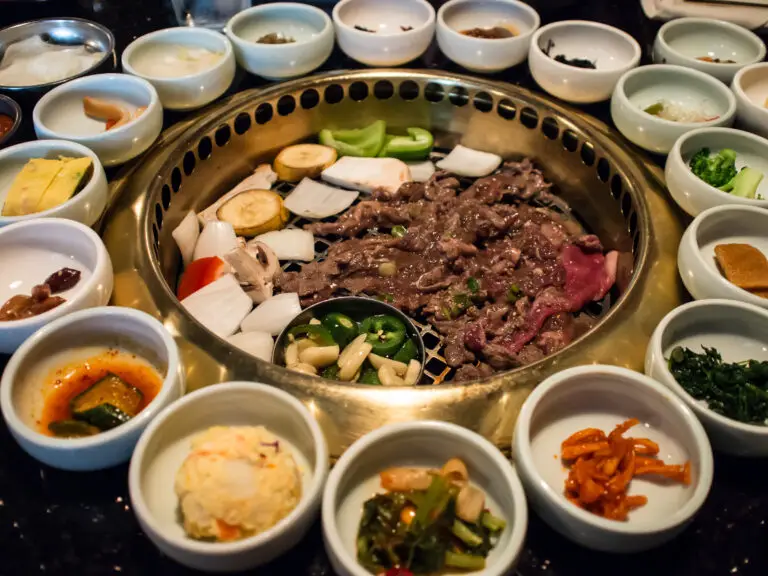
🍲 2. Stews & Soups (찌개 및 국)
📍 Best for: Comfort food lovers, cold weather
💰 Price Range: 7,000–20,000+ KRW per person
Satisfy your soul with Korea’s most beloved comfort food—stews and soups.
Korean stews and soups are warming, hearty, and often spicy meals served bubbling hot in stone or ceramic pots. They are usually enjoyed with a bowl of rice and a side spread of kimchi, pickles, and other banchan. Each stew has a distinct personality—some are spicy, others are savory or fermented, and many are packed with tofu, vegetables, and meat or seafood.
Must-Try:
Kimchi Jjigae (김치찌개): Spicy fermented kimchi stew with tofu and pork. It offers a complex, tangy flavor with a rich broth that deepens as it simmers. (7,000–15,000 KRW per order)
Sundubu Jjigae (순두부찌개): Soft tofu stew, often with seafood or meat. This dish is known for its spicy red broth and creamy tofu that melts in your mouth. (7,000–13,000 KRW per order)
Doenjang Jjigae (된장찌개): Earthy soybean paste stew with veggies and tofu. Fermented doenjang gives it a salty umami punch, balanced by fresh zucchini, mushrooms, and chili. (7,000–13,000 KRW per order)
Samgyetang (삼계탕): Ginseng chicken soup with a whole stuffed chicken. The broth is light but nourishing, believed to replenish energy during hot summers. (15,000–25,000 KRW) per order
Seolleongtang (설렁탕): Milky beef bone soup, mild and hearty. It’s slow-simmered for hours and typically seasoned by the diner with salt, pepper, and green onions. (12,000–16,000 KRW per order)
Galbitang (갈비탕): Beef short rib soup in a clear broth. Tender ribs are the centerpiece, complemented by glass noodles and daikon radish. (15,000–25,000 KRW per order)
Budae Jjigae (부대찌개): “Army stew” with sausage, kimchi, and noodles. A fusion dish born from post-war scarcity, it’s now a spicy, savory comfort classic. (20,000–30,000 KRW per order)
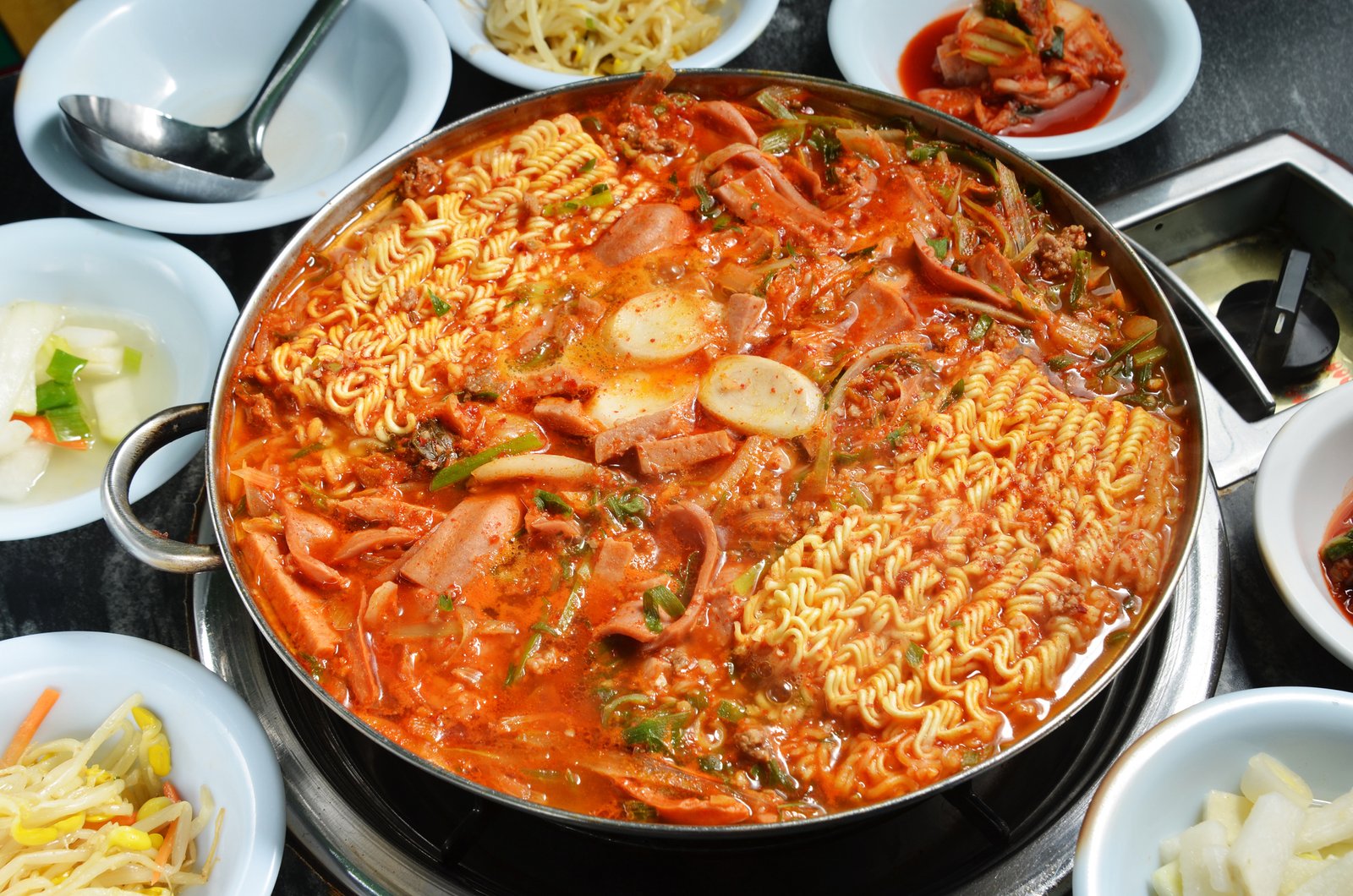
🍜 3. Noodles (면류)
📍 Best for: Quick meals, noodle lovers
💰 Price Range: 7,000–17,000 KRW per person
Noodles in Korea come in hot, cold, spicy, and savory forms—each worth slurping.
Korean noodle dishes offer comfort and variety—from refreshing cold noodles in the summer to steamy seafood broths in the winter. They’re commonly found in humble eateries and food courts, making them accessible and quick for busy travelers. Some dishes feature chewy buckwheat noodles, others are made with hand-cut wheat noodles, and all are bursting with flavor.
Must-Try:
Naengmyeon (냉면): Cold buckwheat noodles in icy beef broth or spicy sauce. Refreshing and tangy, this dish is popular during summer and often garnished with pear, cucumber, and boiled egg. (7,000–12,000 KRW per order)
Jajangmyeon (자장면): Black bean noodles with pork and onions. The rich, savory sauce is both comforting and mildly sweet, making it a Korean-Chinese favorite. (7,000–12,000 KRW per order)
Japchae (잡채): Stir-fried sweet potato noodles with vegetables and beef. Often served during celebrations, it features a light soy-sesame flavor with chewy texture. (9,000–15,000 KRW per order)
Jjampong (짬뽕): Spicy seafood noodle soup with bold broth. It’s filled with mussels, squid, and shrimp in a fiery red soup that packs heat and depth. (9,000–15,000 KRW per order)
Kalguksu (칼국수): Hand-cut noodles in mild anchovy or chicken broth. The soft noodles and clean, savory broth make it perfect for a light meal. (7,000–12,000 KRW per order)
Bibim-guksu (비빔국수): Spicy cold noodles with gochujang and veggies. A tangy, sweet-spicy summer dish often topped with sesame seeds and cucumber. (7,000–10,000 KRW per order)
Ramyeon (라면): Korean instant noodles, often customized with toppings. Comforting and cheap, it’s commonly upgraded with egg, cheese, or kimchi. (3,000–6,000 KRW per order)
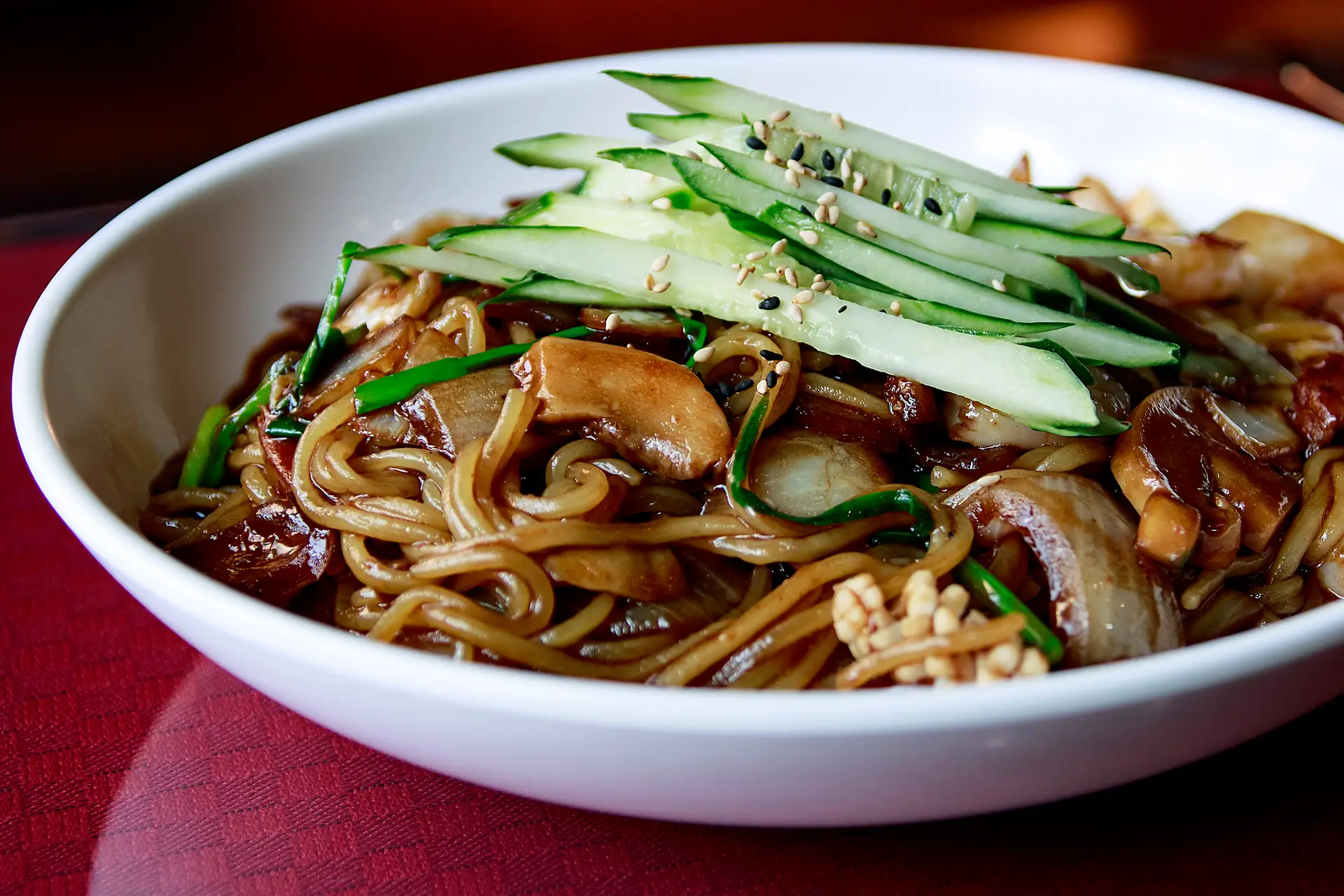
🍚 4. Rice Dishes (밥류)
📍 Best for: Balanced meals, healthy eaters
💰 Price Range: 3,000–15,000 KRW per person
Korean rice bowls like bibimbap and dolsot bibimbap are colorful, balanced, and filling.
Korean rice dishes offer a comforting and nutritious base for countless meal combinations. With a focus on harmony and balance, rice is often served with seasoned vegetables, meat or tofu, sauces, and side dishes. These meals are perfect for travelers looking for healthier, budget-friendly, and customizable options. Whether you're dining on bibimbap or grabbing kimbap for the road, rice dishes are delicious staples.
Must-Try:
Bibimbap (비빔밥): Steamed rice with assorted vegetables, gochujang, and sometimes egg or beef. It's visually striking and meant to be mixed thoroughly before eating, offering balanced textures and flavors in each bite. (8,000–13,000 KRW per order)
Dolsot Bibimbap (돌솥비빔밥): Crispy rice served in a hot stone bowl. The heat creates a golden crust on the bottom and keeps the dish piping hot throughout the meal. (10,000–15,000 KRW per order)
Kimbap (김밥): Seaweed rice roll filled with veggies and proteins. Often likened to sushi, it's portable, affordable, and comes in many variations including tuna, cheese, or bulgogi. (3,000–6,000 KRW per order)
Bokkeumbap (볶음밥): Korean fried rice with vegetables and protein. A great way to use leftovers, it's frequently served with a fried egg on top and flavored with kimchi or soy sauce. (5,000–12,000 KRW per order)
Omurice (오므라이스): Omelette-wrapped fried rice. This Korean-Japanese fusion dish features ketchup-seasoned rice enveloped in a soft egg blanket. (7,000–12,000 KRW per order)
Jumeokbap (주먹밥): Hand-shaped rice balls. These rice balls are often mixed with tuna, seaweed flakes, or spicy sauce, and are perfect as a snack or picnic food. (3,000–5,000 KRW per order)
Kongnamul-bap (콩나물밥): Soybean sprout rice. A healthy, clean dish typically accompanied by a spicy sauce or soup, emphasizing subtle, earthy flavors. (7,000–10,000 KRW per order)
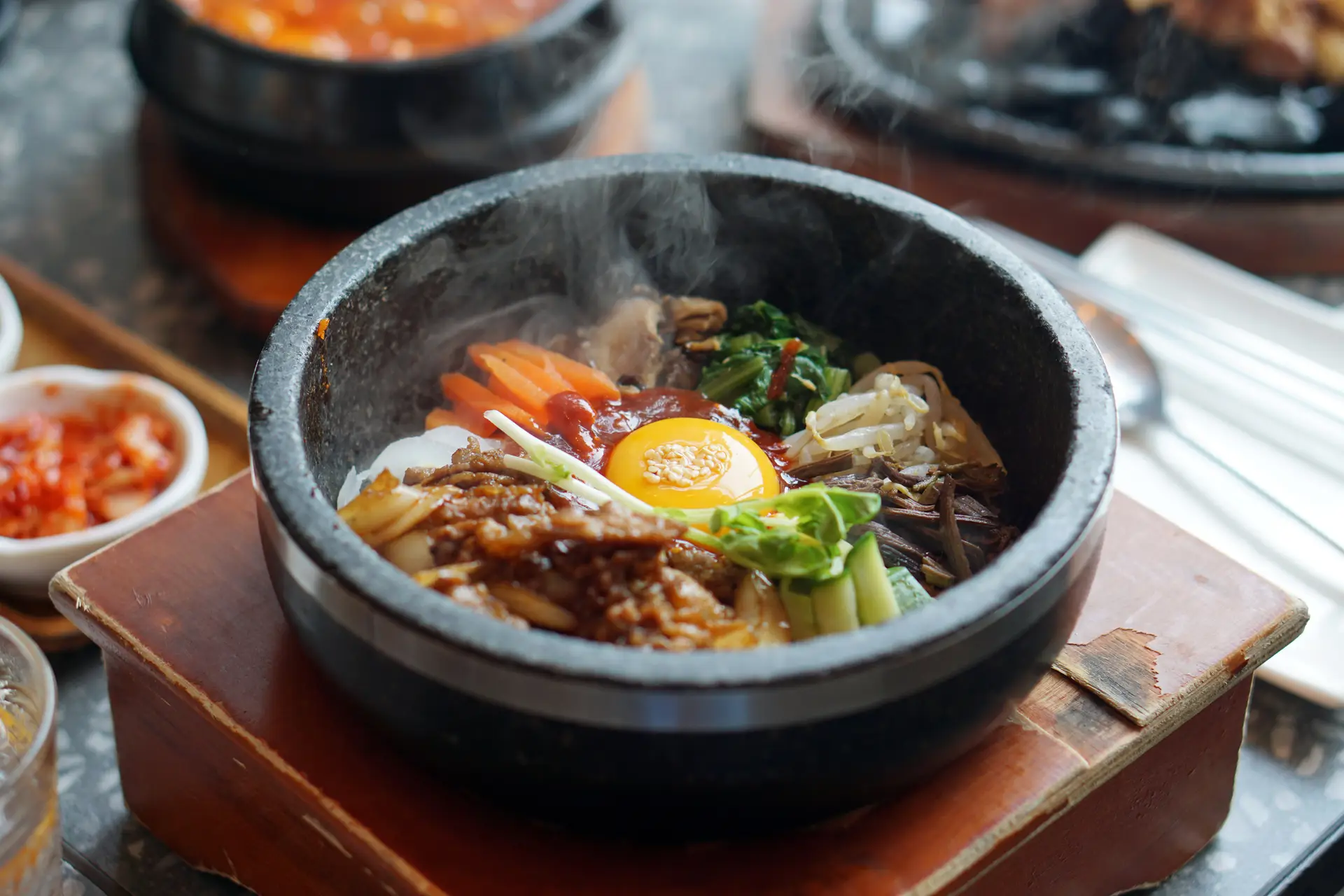
🍢 5. Street Foods & Snacks (길거리 음식)
📍 Best for: On-the-go eats, budget travelers
💰 Price Range: 1,000–8,000 KRW per person
Experience Korean street food culture in vibrant local markets.
Korea’s street food scene is an exciting way to experience local flavors affordably and conveniently. Found in night markets and around subway stations, street snacks range from savory to sweet and are great for travelers on the go. You’ll find locals lining up for classics like tteokbokki and newcomers raving about egg bread. Bring cash, an appetite, and an open mind!
Must-Try:
Tteokbokki (떡볶이): Spicy-sweet rice cakes. These chewy rice cylinders are simmered in gochujang-based sauce and often served with fish cakes and boiled eggs. (4,000–6,000 KRW per order)
Hotteok (호떡): Brown sugar-filled pancakes. Pan-fried until crispy, the inside melts into a gooey, cinnamon-scented syrup with nuts and seeds. (1,000–2,000 KRW per order)
Sundae (순대): Korean blood sausage. Made from pig intestine stuffed with noodles and rice, it's savory, chewy, and often dipped in seasoned salt or chili paste. (4,000–6,000 KRW per order)
Twigim (튀김): Fried snacks like dumplings and vegetables. A Korean version of tempura, these snacks are crispy on the outside and can include squid, seaweed rolls, and sweet potato. (3,000–6,000 KRW per order)
Mandu (만두): Dumplings, steamed or fried. They can be filled with meat, tofu, or kimchi and served solo or in soup. (5,000–8,000 KRW per order)
Gyeran-ppang (계란빵): Sweet egg bread. A mini loaf with a whole egg baked inside, soft and fluffy with a slightly sweet batter. (1,000–2,000 KRW per order)
Odeng (오뎅): Fish cake skewers in broth. Served in hot broth from street carts, it’s a quick, warming snack. (500–2,000 KRW per order)

🍗 6. Fried Chicken (치킨)
📍 Best for: Late-night snacks, casual groups
💰 Price Range: 9,000–15,000 KRW per person
Korean fried chicken is double-fried for extra crispiness and perfect with beer.
Korean fried chicken is known worldwide for its super crispy skin and bold sauces. Thanks to double frying, it's less greasy and incredibly crunchy. Whether you're ordering soy garlic or spicy yangnyeom, Korean fried chicken is often eaten with pickled radish and beer (aka “chimaek”). It’s great for sharing and a go-to comfort food for locals.
Must-Try:
Plain Fried Chicken (후라이드 치킨): Classic Korean-style fried chicken served without sauce. It’s double-fried for extra crispiness and best enjoyed with pickled radish and a cold beer. (16,000–22,000 KRW)
Yangnyeom Chicken (양념치킨): Sweet and spicy glazed fried chicken. The sauce is sticky, vibrant, and rich in flavor—perfect for heat-seekers. (17,000–22,000 KRW per order)
Soy Garlic Chicken (간장치킨): Savory and aromatic fried chicken. Coated in a sticky soy sauce blend with a hint of garlic, it’s savory with just a touch of sweetness. (17,000–22,000 KRW per order)
Honey Butter Chicken: Sweet buttery coating, rich and indulgent. This flavor exploded in popularity for its dessert-like twist on savory fried chicken. (18,000–23,000 KRW per order)
Cheese Chicken: Topped with melted cheese. Often served sizzling with mozzarella or cheddar, it’s creamy and salty—a comfort food indulgence. (18,000–23,000 KRW per order)
Ganjang Chicken (간장치킨): Soy-marinated with sesame and garlic. Balanced and less sweet than soy garlic, this is a more traditional Korean approach. (18,000–23,000 KRW per order)
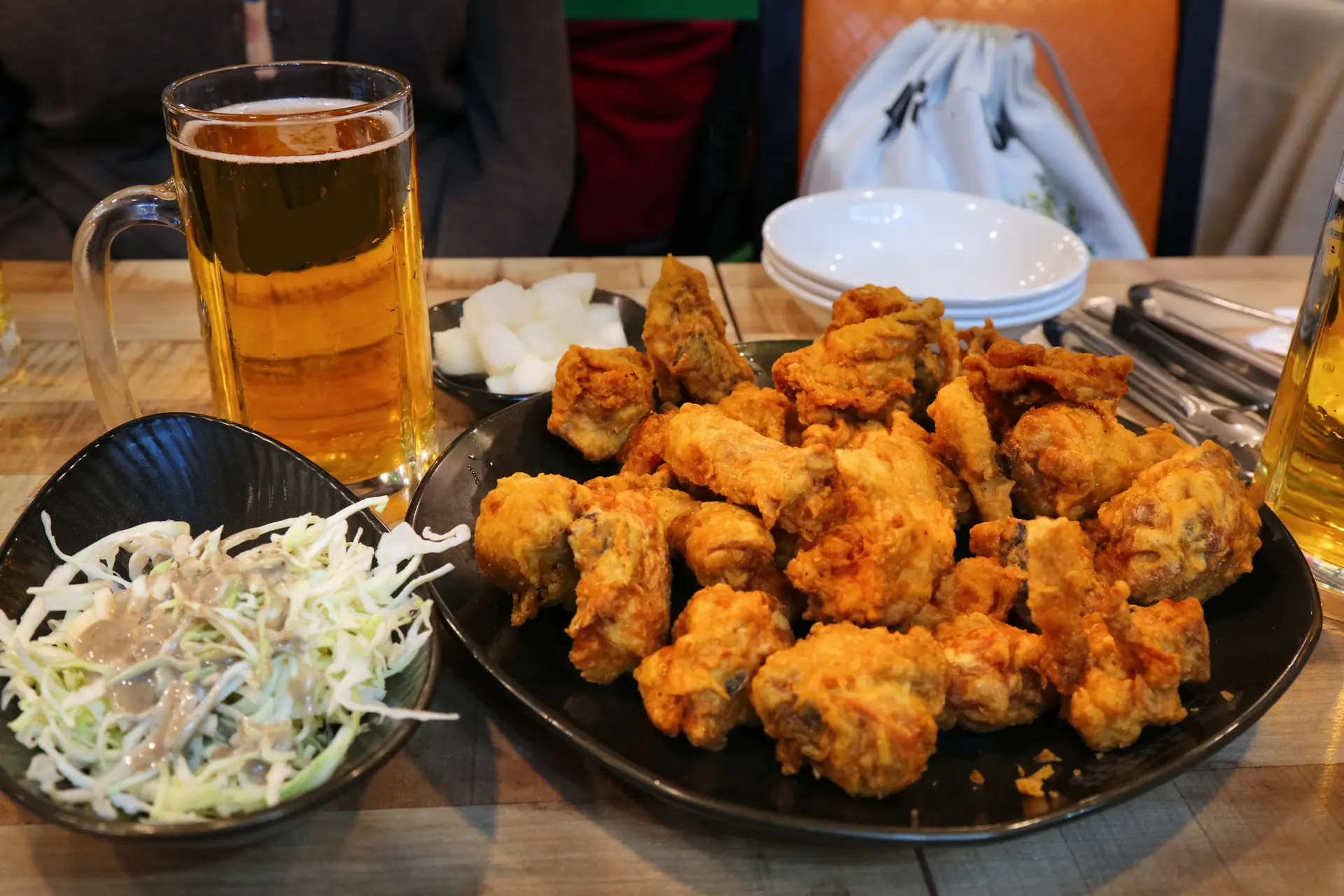
🐟 7. Seafood (해산물)
📍 Best for: Coastal dining, seafood lovers
💰 Price Range: 15,000–45,000+ KRW per person
Fresh seafood from Korea’s markets and coastlines brings ocean flavors to the table.
Thanks to its coastline, South Korea offers a fantastic variety of seafood, served grilled, raw, braised, or pan-fried. Seafood is especially beloved in port cities like Busan, where markets serve freshly caught fish. From luxurious sashimi platters to comforting seafood pancakes, these dishes highlight the bounty of the sea and the seasonal rhythms of Korean cuisine.
Must-Try:
Haemul Jjim (해물찜): Braised seafood dish with crab, clams, shrimp, and squid in a spicy red pepper sauce. It’s served hot with bean sprouts and perilla leaves, often shared among groups. (25,000–50,000+ KRW per order)
Hoe (회): Sliced raw fish served with vinegar gochujang sauce. Korean sashimi tends to be chewier than Japanese styles and is often eaten with lettuce wraps. (25,000–60,000+ KRW per order)
Grilled Fish (생선구이): Salted and grilled whole mackerel or pollack. Served with rice and banchan, this dish is simple, hearty, and packed with flavor. (13,000–30,000 KRW per order)
Agujjim (아구찜): Spicy braised monkfish with bean sprouts. This spicy dish has a chewy texture and is usually shared at the table. (30,000–50,000 KRW per order)
Ganjang Gejang (간장게장): Soy sauce-marinated raw crab, nicknamed the "rice thief." Its sweet-salty brine enhances the creamy crab meat, making it addictively delicious. (25,000–45,000 KRW per order)
Jogae Gui (조개구이): Grilled shellfish, often clams and scallops, cooked over open flames at the table. Served with butter, cheese, or spicy sauce, it's a popular dish at coastal restaurants and seafood markets. (20,000–40,000+ KRW per order)
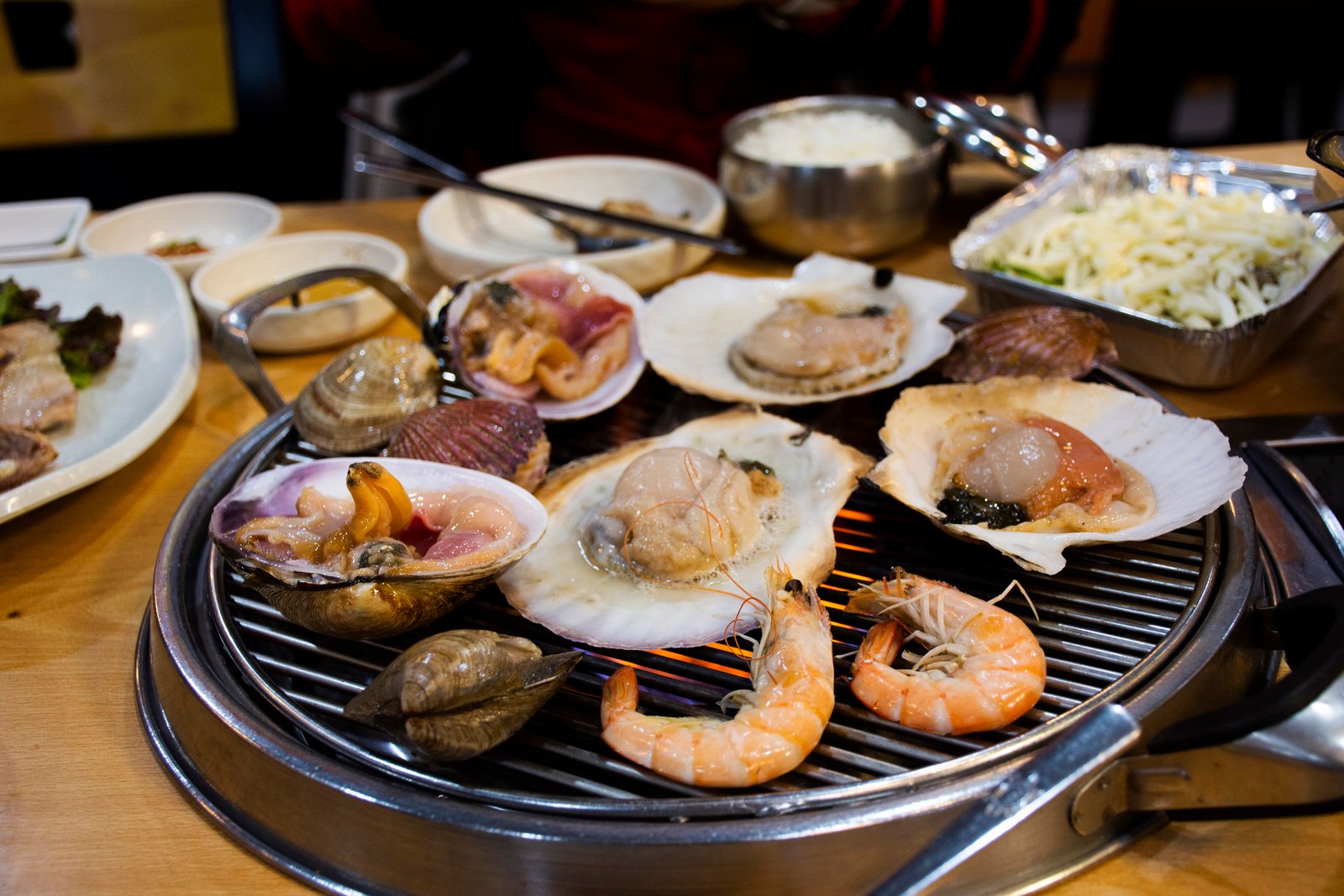
🥩 8. Non-BBQ Meat Dishes
📍 Best for: Hearty meals, comfort seekers
💰 Price Range: 10,000–25,000+ KRW per person
Slow-braised, fried, and savory meat dishes are a comfort food favorite in Korea.
Beyond BBQ, Korea serves up rich and flavorful meat dishes prepared in diverse ways—from deep frying to long, slow braising. Many of these meals are designed for sharing, making them ideal for family-style dining. Whether it’s a plate of crispy pork cutlet or a bubbling pot of spicy chicken stew, these dishes are deeply satisfying.
Must-Try:
Tonkatsu (돈가스): Deep-fried pork cutlet with sweet sauce and cabbage. It’s served with a side of rice, sometimes curry, and is a popular lunch option. (10,000–15,000 KRW per order)
Jokbal (족발): Soy-braised pig trotters, gelatinous and rich. Often paired with lettuce wraps, garlic, and fermented shrimp sauce. (25,000–50,000 KRW per order)
Galbi-jjim (갈비찜): Braised beef short ribs with jujubes and chestnuts. The meat is tender and the sauce is thick, sweet-savory, and aromatic. (30,000–60,000+ KRW per order)
Bossam (보쌈): Boiled pork belly served with kimchi and cabbage wraps. A popular meal for groups, especially during kimchi-making season. (25,000–50,000 KRW per order)
Dakdoritang (닭도리탕): Spicy chicken stew with vegetables. Braised with gochugaru and soy sauce, this dish is hearty, spicy, and perfect with rice. (18,000–25,000 KRW per order)
Tangsuyuk (탕수육): Korean-Chinese sweet and sour pork, deep-fried and served with a glossy, tangy sauce made from vinegar, sugar, and vegetables. Crunchy on the outside and juicy inside, it’s a popular dish for sharing. (15,000–30,000 KRW per order)
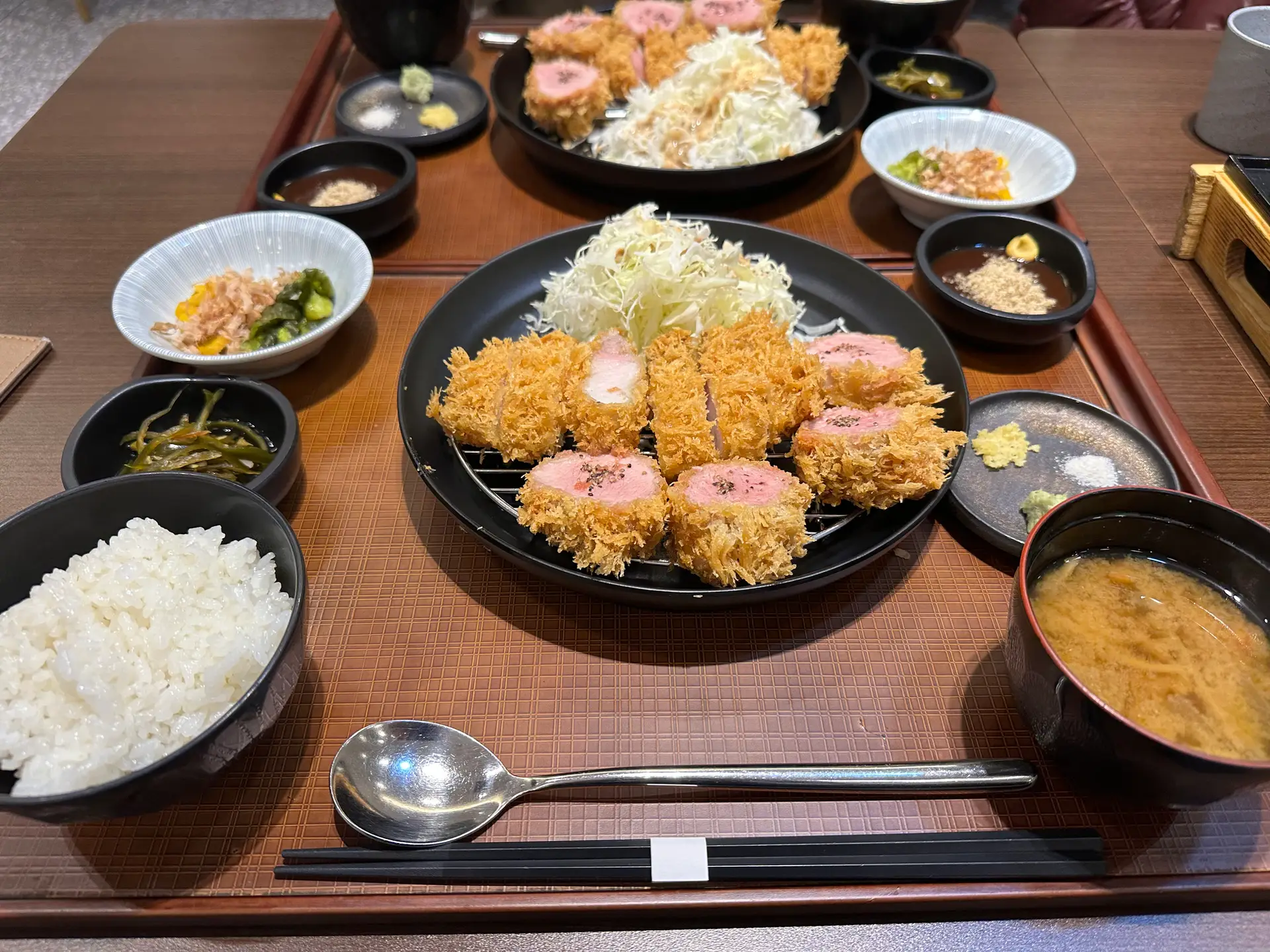
🍧 10. Desserts & Sweets (디저트)
📍 Best for: After-meal treats, sweet tooth cravings
💰 Price Range: 1,000–12,000+ KRW
Satisfy your sweet tooth with traditional and trendy Korean desserts.
Korean desserts strike a balance between tradition and innovation, offering subtle sweetness and unique textures. While rice, red beans, and honey form the core of many traditional sweets, modern cafés serve visually stunning creations like bingsu topped with fruit, matcha, or cheesecake. You’ll find dessert cafés all over Korea, each with their own creative spin.
Must-Try:
Bingsu (빙수): Shaved ice dessert topped with fruit, red beans, or condensed milk. It comes in many flavors like mango, strawberry, or green tea and is often large enough for sharing. (15,000–25,000+ KRW per order)
Yakgwa (약과): Honey cookies fried and soaked in syrup. These chewy, flower-shaped treats are made with sesame oil and wheat flour and are a favorite during holidays. (1,000–2,500 KRW per piece per order)
Hodugwaja (호두과자): Walnut pastries filled with red bean paste. Bite-sized and shaped like walnuts, they’re commonly sold in train stations and are great for gifting. (7,000–15,000 KRW per order)
Chapssaltteok (찹쌀떡): Korean mochi filled with sweet red bean paste. Soft and chewy with a slightly sticky texture, often dusted with bean powder. (1,000–2,000 KRW each)

☕ 11. Drinks & Beverages (음료)
📍 Best for: Staying refreshed, experiencing local drink culture
💰 Price Range: 1,000–8,000+ KRW per person
From traditional teas to trendy cafés and iconic soju, Korean drinks enhance any meal.
Whether you're sipping hot barley tea in a traditional restaurant or enjoying iced coffee in a high-end café, Korea offers a wide variety of beverages for every taste. Alcoholic drinks are deeply tied to Korean dining and social culture, while non-alcoholic options range from herbal teas to juices. Beverages are an integral part of mealtime and hospitality.
Must-Try:
Makgeolli (막걸리): Cloudy, slightly sweet rice wine. Traditionally drunk from bowls, it pairs well with savory dishes like jeon (Korean pancakes). (4,000–8,000 KRW per bottle)
Soju (소주): Korea’s most popular liquor, often enjoyed with BBQ. Clear and strong, it comes in original and fruit flavors like peach or grapefruit. (4,000–6,000 KRW in restaurants)
Barley Tea (보리차): Nutty, caffeine-free roasted barley tea. Served hot or cold, it's commonly offered in homes and restaurants. (1,000–2,000 KRW)
Corn Tea (옥수수차): Mild, caffeine-free tea made from roasted corn. Often served warm with a slightly sweet flavor. (1,000–2,000 KRW)
Specialty Coffee (스페셜티 커피): Found in trendy cafés, includes lattes, cold brews, and espresso drinks. Korean cafés are known for beautifully presented drinks and cozy atmospheres. (3,000–8,000+ KRW)
Sikhye (식혜): Sweet fermented rice drink served cold. Mild and refreshing with floating rice grains, it's a common drink in traditional Korean meals. (2,000–4,000 KRW)
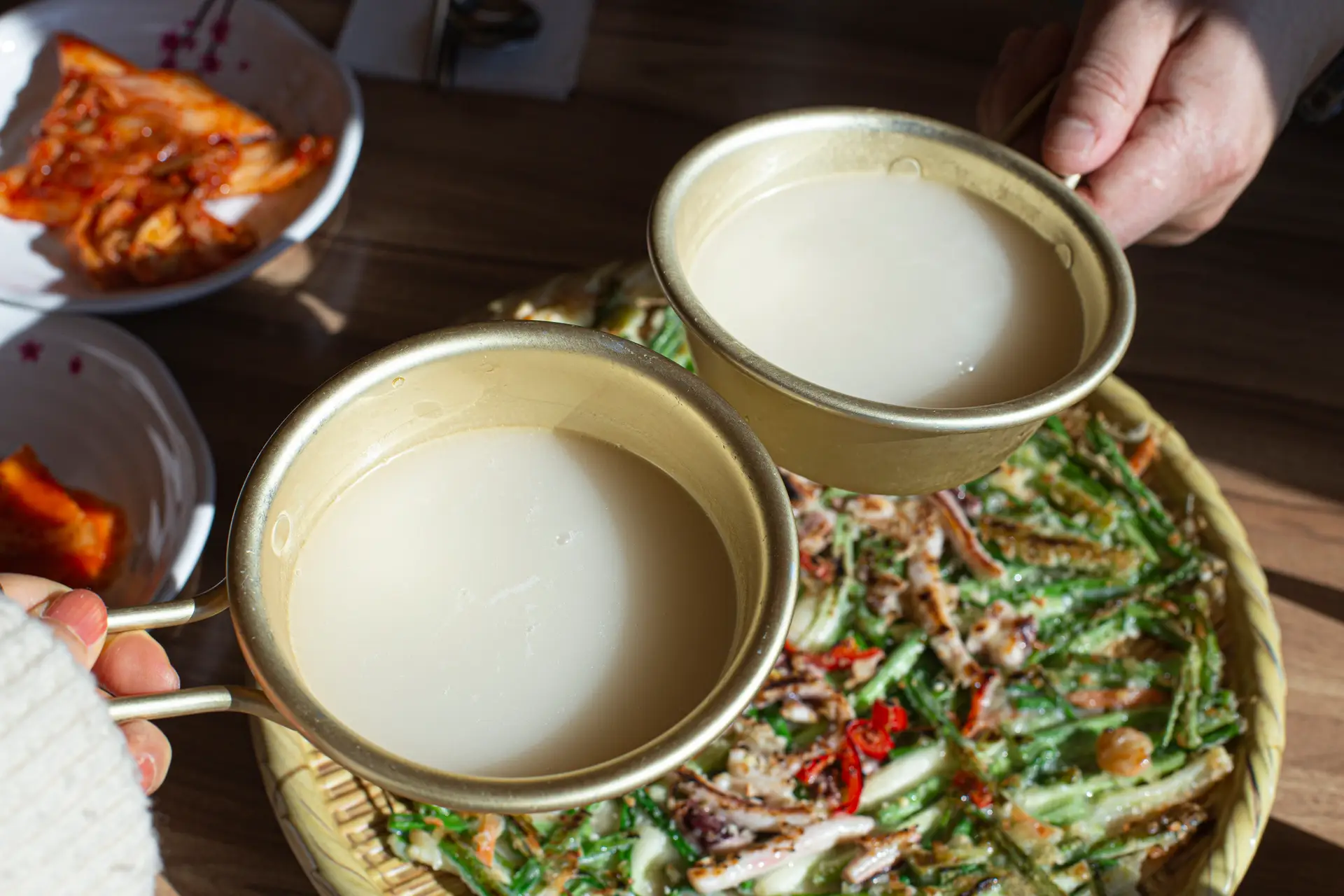
🥞 12. Korean Pancakes (전)
📍 Best for: Savory snack lovers, rainy days
💰 Price Range: 8,000–15,000 KRW per person
Korean pancakes are golden, crispy, and often shared with a bottle of makgeolli.
Korean pancakes, or jeon, are a go-to comfort food, especially on rainy days. These savory pan-fried treats are made with various ingredients like green onions, kimchi, or seafood in a flour-and-egg batter. Best enjoyed with a dipping sauce made of soy sauce and vinegar, jeon is often paired with makgeolli (rice wine) and shared among friends.
Must-Try:
Haemul Pajeon (해물파전): Green onion pancake with shrimp, squid, and clams. The seafood adds briny flavor while the crispy edges bring satisfying texture. (15,000–25,000 KRW per order)
Kimchi Jeon (김치전): Pancake made with well-fermented kimchi, slightly spicy and tangy. Pairs well with cold makgeolli and is a favorite rainy-day snack. (10,000–15,000 KRW per order)
Gamja Jeon (감자전): Crispy pancake made from grated potatoes. Often served with dipping sauce, it’s a soft-centered, golden-brown comfort food. (10,000–15,000 KRW per order)
Bindaetteok (빈대떡): Savory mung bean pancake mixed with vegetables and ground meat or kimchi. It’s pan-fried until golden brown and commonly eaten with a soy dipping sauce and makgeolli. (6,000–10,000 KRW per order)
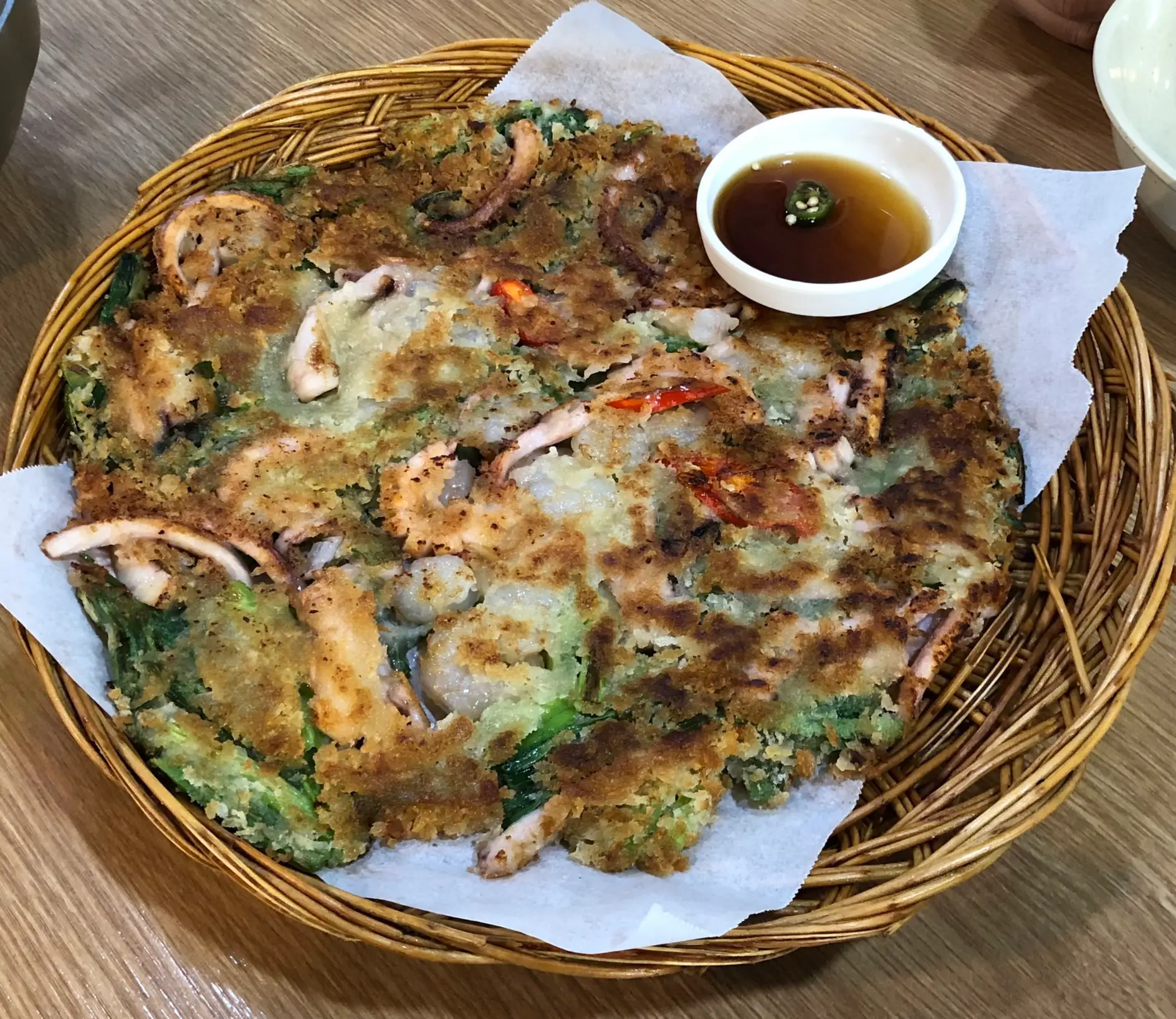
🥟 13. Dumplings (만두)
📍 Best for: Dumpling enthusiasts, cozy meals
💰 Price Range: 6,000–9,000 KRW per person
Mandu can be steamed, fried, or boiled—each with its own delicious charm.
Korean dumplings, or mandu, are versatile and satisfying. They come in different shapes and sizes, filled with a mixture of meat, tofu, vegetables, and sometimes kimchi. Mandu can be enjoyed as a snack, appetizer, or main dish and are commonly served with soy dipping sauce.
Must-Try:
Gun Mandu (군만두): Pan-fried dumplings with crispy bottoms. These dumplings are seared to a golden brown, creating a contrast between the crunchy exterior and juicy filling. (6,000–9,000 KRW per order)
Jjin Mandu (찐만두): Steamed dumplings with soft, chewy skins. Served piping hot, these fluffy mandu are often accompanied by tangy soy vinegar sauce. (6,000–9,000 KRW per order)
Kimchi Mandu (김치만두): Dumplings filled with spicy fermented kimchi. A flavorful choice for spice lovers, often enjoyed in soups or steamed. (6,000–9,000 KRW per order)
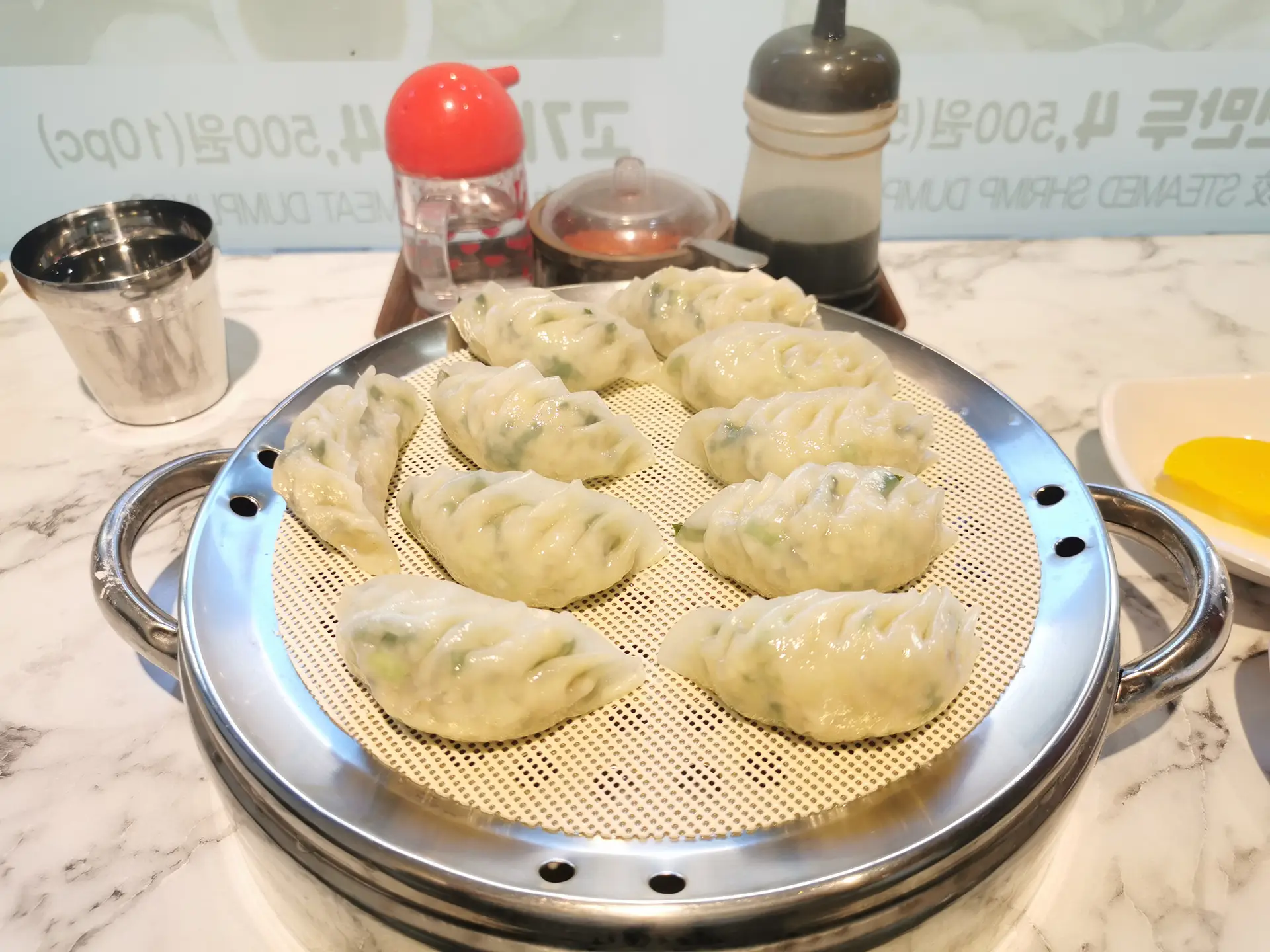
🍱 14. Traditional Set Meals (한정식)
📍 Best for: Food explorers, cultural immersion
💰 Price Range: 15,000–60,000+ KRW per person
A Korean table set with dozens of banchan is a feast for both eyes and appetite.
Hanjeongsik is the ultimate Korean dining experience, offering a full spread of rice, soup, grilled fish or meat, and a variety of seasonal side dishes. Traditionally served in royal courts, this meal showcases the best of Korean flavors and aesthetics. It's a great way to sample many different dishes at once and gain a deep appreciation for the balance in Korean cuisine.
Must-Try:
Bulgogi Hanjeongsik (불고기 한정식): Set meal with marinated beef and full side dish array. Usually includes soup, salad, pickled sides, and rice for a well-rounded meal. (20,000–40,000 KRW per person)
Vegetarian Hanjeongsik: A temple-style version using tofu, vegetables, and fermented dishes. Offers clean, balanced flavors and is ideal for those avoiding meat or strong spices. (15,000–25,000 KRW per person)
Premium Hanjeongsik: Includes grilled fish, premium meat cuts, and 10+ side dishes. Often served in high-end restaurants with beautiful presentation. (30,000–60,000+ KRW per person)
Japanese Hanjeongsik (일식 한정식): A Korean take on Japanese-style set meals, often including rice, miso soup, grilled fish, sashimi, and pickled vegetables. It’s a balanced and beautifully presented option served in many fusion or Japanese restaurants in Korea. (30,000–60,000+ KRW per person)
Chinese Hanjeongsik (중식 한정식): A Korean interpretation of Chinese-style course meals featuring dishes like tangsuyuk, jjajangmyeon, and spicy stir-fried seafood. Often served as a multi-course set with sides and rice, blending Korean and Chinese culinary elements. (25,000–55,000+ KRW per person)

🧭 15. Final Tips for Food Lovers in Korea
📍 Best for: Everyone visiting Korea for a food-focused adventure
Enjoying a shared Korean meal is about both food and connection.
Korean cuisine is a journey into a culture that values balance, harmony, and shared experiences. As you travel through South Korea, be open to trying new textures, flavors, and ingredients. Food is central to Korean hospitality, and whether you’re eating at a traditional market stall or a contemporary fusion café, the goal is always connection through shared meals.
✨ Quick Travel Tips:
💸 Budget-Friendly Choices: Street food, kimbap shops, and noodle stalls offer filling meals for 3,000–8,000 KRW.
🧂 Dietary Needs: Check broths for meat or fish base. Use translation cards or apps to communicate dietary restrictions.
🥢 Dining Etiquette: Wait to be seated. Don't stick chopsticks vertically in rice. Pour drinks for others before yourself.
🥘 Splurge Experiences: Korean BBQ, seafood towers, and temple cuisine can run from 20,000 to 100,000+ KRW depending on location and ingredients.
🎒 Pro Tip: Save this guide offline or in your travel app for quick reference on the go. With so many options, Korea is truly a paradise for food lovers!
📌 Pin this guide or bookmark it before your next trip to Korea!
